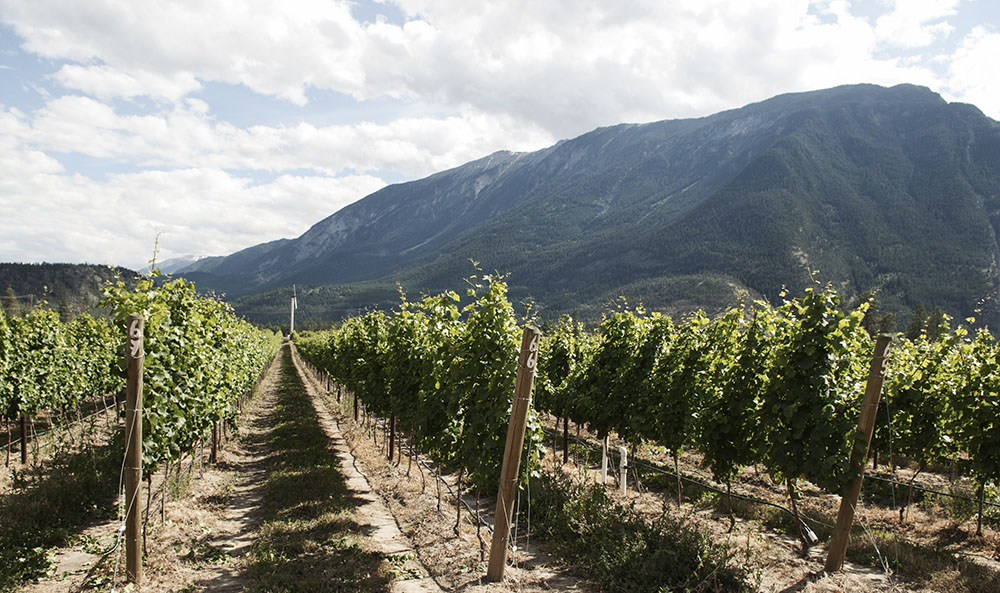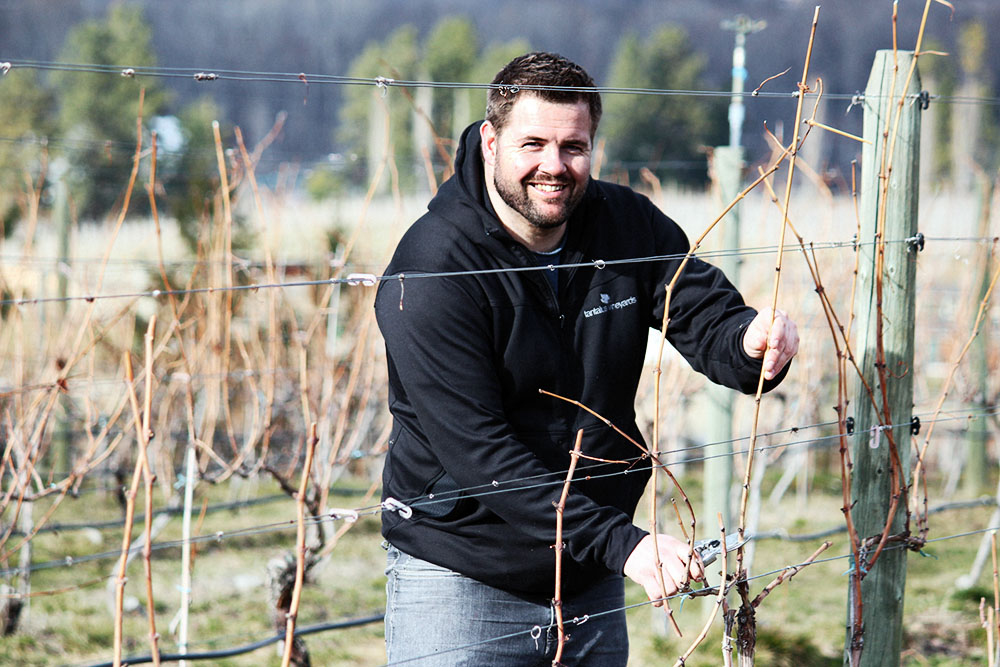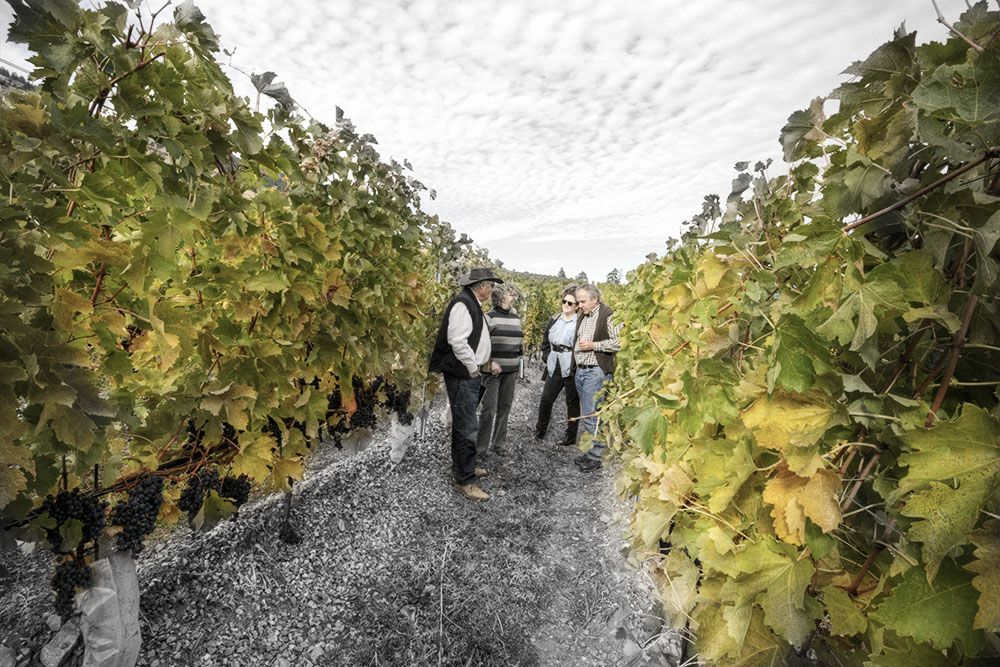
After decades of being used, abused and generally misunderstood, is BC Riesling finally getting the respect it deserves?
To better comprehend the challenges faced by Riesling in Canada’s westernmost province, you have to go back more than 40 years, to 1977. That was when the marketing gurus at Calona Wines (now owned by Andrew Peller Limited) launched Schloss Laderheim. Their intent? Take firm aim at imported — as in German — Riesling and its various blended iterations. These cheap wines were threatening the dominance of the major Canadian wineries, propped up, as they were — and some insist still are — by government bias.
Calona’s plan succeeded. The brown “hock” bottle, complete with its cheesy, made-up German-sounding name, took the cheap wine market by storm. Four years later, Schloss Laderheim had left even Baby Duck in its wake. Not surprisingly, when Calona’s competitors witnessed its success, they felt obliged to emulate it with a string of knock-offs.
In essence, they cemented the foundation for Canada’s worldwide wine embarrassment, the Cellared in Canada — now International Canadian Blend — fiasco. The legacy of that original onslaught lingered long in the consumer’s mind. Even today, the less informed continue to associate Riesling with a sweeter, not off-dry or drier wine. Happily, though, there are signs that perception is changing.
Tantalus’ success with Riesling is rubbing off on other BC wineries
The reasons for Riesling’s resilience are many. For one, its lengthy history, which dates from Roman times. Somewhat more recently, the variety was popularized by Queen Victoria and her consort, Prince Albert, when they visited the Rheingau in 1845. The young royals were akin to modern-day rockstars, the Charles and Diana of their era, dedicated to reinventing the monarchy. That was well before the German wine industry turned its attention to higher-producing varieties, such as Sylvaner, and poor-quality blends for export. Riesling begin to wane.
Among BC’s early wine pioneers was a handful of Riesling “believers” whose conviction was reinforced by the Geisenheim Grape Breeding Institute’s Dr Helmut Becker, who included the variety in his 1970s trials. In fact, in his test plantings, Riesling proved reliable throughout much of the Okanagan Valley — which was distinctly more “cool climate” 50 years ago than it is today.
It was only natural that all the original farm-gate wineries with strong German connections, such as Gehringer, Gray Monk, Lang and Wild Goose, would plant Riesling at the outset. As Wild Goose’s founder, the late Adolf Kruger, once said, “I lived on the Rhine and wine was cheaper than beer. And we drank predominantly Riesling, so that’s what we planted.”
While some dabbled in drier styles, off-dry wines were these wineries’ bread and butter. They proved to be popular drops, an easy sale in the tasting room. The wines showed a purity of fruit buoyed by the Okanagan’s trademark acidity. They were rarely actually “sweet” — unless purposefully made in a late-harvest or Icewine style.
In 1978, the late Denis Dulik planted Riesling in part of the former Pioneer Vineyard in East Kelowna, which he had purchased from legendary grower J.W. Hughes. BC wine authority John Schreiner notes that Dulik (who previously had grown only Labrusca) was encouraged to plant Riesling by Jordan and Ste-Michelle winemaker Josef Zimmerman. He was convinced that Riesling was as ideally suited to the Okanagan as proven German regions like Mosel and the Rheingau.

With rootstock sourced from St Urbans-Hof, Dulik’s plantings soon paid off. The 1981 vintage took a gold medal at what later became the Okanagan Wine Festival. His daughter Susan Dulik later established Pinot Reach Cellars, which was sold in 2004 and became the genesis for Tantalus Vineyards. Despite the change in ownership, Denis Dulik continued to work for Tantalus in the vineyard he had established.
Arguably the world’s leading Riesling authority (and certainly its most vocal advocate) is Planet Riesling author Stuart Pigott. When Pigott visited the Okanagan a few years back, he visited Tantalus and Okanagan Falls’ Synchromesh Wines. After tasting their wines, he anointed some as “blade-runners,” his self-coined and entirely appropriate label for wines that reward with a certain steeliness and clarity.
It’s those characteristics — more the tension that defines the wine’s style than its actual sweetness or dryness — that has captured the imagination of a growing number of winemakers.
While the aforementioned two wineries have come to be regarded as Riesling standard bearers, others are following suit. The variety is now produced on a much wider scale. It’s presently grown throughout the central and northern Okanagan, and beyond, including in the Similkameen Valley, as well as in Kamloops and Lillooet. Plantings are also moving to higher elevations, as in Culmina’s Margaret’s Bench, near Oliver, and Okanagan Crush Pad’s Garnet Valley, near Summerland.
Tantalus Vineyards Riesling 2018, Okanagan Valley ($22)
Hand-harvested from a variety of blocks, including the original 1978 East Kelowna planting. Fruit from each block was fermented separately and later blended. Upfront citrus, floral and mineral notes, followed by a juicy, vibrant palate of tropical and lime notes wrapped in juicy acidity, with excellent length and zesty aftertaste.
Tantalus Vineyards Old Vines Riesling 2016, Okanagan Valley ($30)
One hundred percent fruit from the original planting. Hand-harvested and fermented almost completely dry. Forward, intense lemon-lime notes with stony undertones, followed by textured layers of peach and citrus with racy but keenly focused and well-balanced acidity throughout. Another outstanding example of Riesling’s true potential from this site.
Tantalus Vineyards Den’s Block 2016, Okanagan Valley ($55)
Winemaker David Paterson describes this fitting tribute to the pioneering Denis Martin Dulik as his “first Spatlese style.” Hand-picked and whole-bunch pressed then wild fermented in neutral oak. Bottled after five months on lees and aged two years in bottle. Evolving petrol notes with intense tropical, citrus and stone-fruit aromas preceding a luscious but firmly focused palate defined by bright acidity and keen minerality through a lengthy finish.
Kitsch Wines Maria’s Block Riesling 2017, Okanagan Valley ($25)
From one of the Okanagan’s rising stars, near Tantalus, a relatively new venture from a family with a long history in the valley. Stone fruit and citrus on the nose, with a hint of developing petrol before a well-balanced lemon-lime palate buoyed by racy acidity through the lingering finish.

The spinoff from Tantalus’ success is also rubbing off on other southeast Kelowna and Mission district wineries. A number of neighbours are helping to solidify Riesling’s reputation as a variety particularly well suited to the central Okanagan. They include nearby Kitsch Wines, Sperling, CedarCreek, St Hubertus and Summerhill, among others. Newcomer Phantom Creek Estates also sourced its inaugural 2017 Riesling from a vineyard adjacent to Tantalus.
And there are signs of winemakers embracing the shift towards drier styles — also seen in Germany with the growing popularity of more Trocken wines. However, much in the way that Riesling’s revolution has been more of an infiltration, the change has been gradual. For the most part, it’s come thanks to the influx of a younger generation of winemakers, many of whom earned their Riesling stripes elsewhere.
Many producers are increasingly moving towards a drier Riesling — though not necessarily to a bone-dry style — while retaining their more off-dry offerings. The much-vaunted revolution still might not quite have happened in BC, at least not yet. But it may well be right around the corner.
Fort Berens Dry Riesling 2017, Lillooet ($20)
All estate-grown fruit, hand-harvested and stainless-steel fermented. Upfront aromas of citrus and orchard fruit, bright green apple and zesty lemon notes with a streak of minerality below zippy acidity, the product of significant diurnal temperatures. Crisp and clean through the finish.
CedarCreek Block 3 Riesling 2017, Okanagan Valley ($30)
From 26-year-old vines on steep, north-facing slopes in South Kelowna, overlooking Okanagan Lake. Eighty percent stainless-steel fermented, with the balance in neutral oak, five months on lees. Upfront stone-fruit and citrus aromas precede a vibrant, racy and mouth-watering palate underpinned by keen acidity through the lengthy finish.
Culmina R&D Dry-ish Riesling 2018, Okanagan Valley ($23)
From Oliver estate-grown fruit. Upfront citrus, mineral and apple notes precede a well-balanced, mouth-watering palate of peach and pineapple notes supported by good mouthfeel and keen acidity through a refreshing finish.
Spearhead Riesling 2018, Okanagan Valley ($22)
Fruit from the Mount Boucherie bench and Gentleman Farmer in Southeast Kelowna. Hand-harvested, whole-bunch pressed and stainless-steel fermented. Upfront floral and citrus notes precede a juicy, stone-fruit, lime and flinty palate with a zesty edge and lingering chalky finish.
